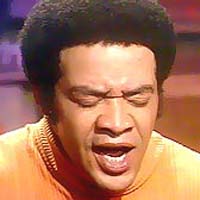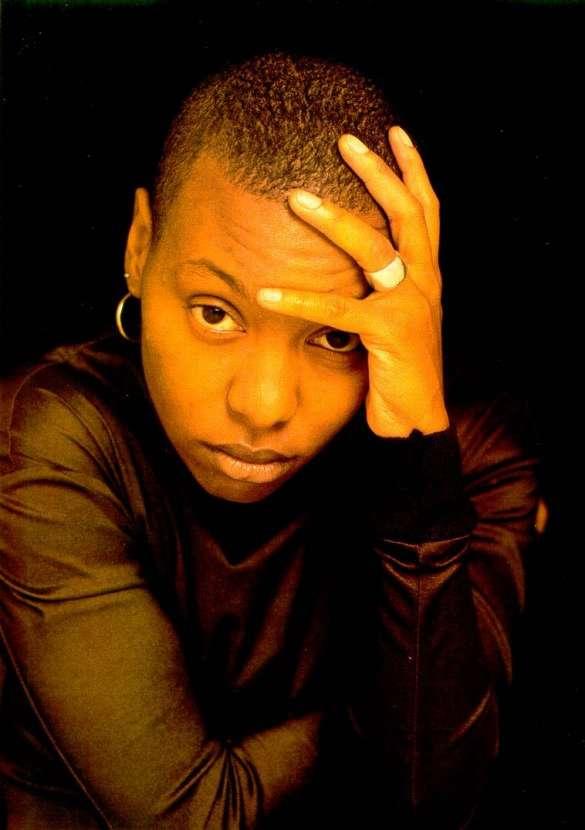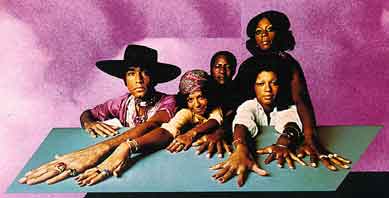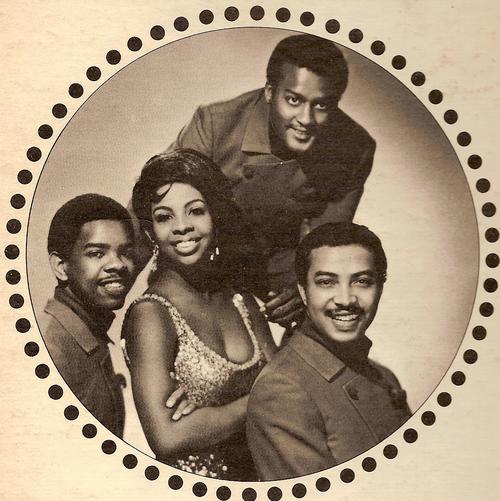MESHELL NDEGEOCELLO / “Who Is He And What Is He To You”
There’s a lot to like about Bill Withers’ two-timing funk classic “Who Is He (And What He Is He To You).” We can start right at the title: I’m a fan of records that announce their intentions before the music even starts. I’m also a fan of song titles that include conjunctions and parenthetical references, so long as it’s done judiciously and appropriately. Bill gets all three done in one fell swoop, so we’re off to a good start. The lyrics start well too:
A man we passed just tried to stare me down And when I looked at you, you looked at the ground I don’t know who he is but I think that you do Dad-gum it, who is he? / And what is he to you?See, right then and there, an entire portrait is painted. A man and his lady walking down the street. Another man approaches and starts looking, then starts staring. The first man looking at the second man, like, “What the hell are you looking at?” Then looking at his woman, like, “What the hell is he looking at?” And then noticing that his woman is intentionally and conspicuously studying her own toenail polish instead of holding her head up like she usually does. You can see the whole thing.
 Other things I dig about the record: Bill’s world-weary tone of voice—I’m thinking he’s been down this road before and probably with the same woman. There’s also that wha-wha guitar chicken-scratching all over the place, sounding like passers-by or some other nosy somebodies all in Bill’s business while he’s already way too busy trying to handle his own.
Other things I dig about the record: Bill’s world-weary tone of voice—I’m thinking he’s been down this road before and probably with the same woman. There’s also that wha-wha guitar chicken-scratching all over the place, sounding like passers-by or some other nosy somebodies all in Bill’s business while he’s already way too busy trying to handle his own.
 Two decades later Meshell Ndegeocello dropped both the parenthesis and the acoustic guitar refrain. Then she cranked up the bass big-time, turning the already-nice bassline of Bill’s into the crushing, rumbling centerpiece of her cover. The most notable thing about her remake isn’t anything she did with the music though, it’s simply that she sang the song word-for-word the way it was originally written. What I’m saying is, she didn’t do anything disingenuous like change the text to, “Who is she and what is she to you?” No, Meshell left Bill's original lyric as it was written. By the time her second album dropped, Meshell had given up any pretence of being in the closet. She was putting it out there. So listening to Meshell's cover gives us a completely different scenario, even though she's describing the same situation.
I have a lot of friends and family in the lesbian community and several of them have told me they watch out for ‘bi’ girls. Bad news, they say. Of course, there are others who actively seek same…I guess it’s the ol’ ‘whatever’s taboo is more exciting’ thing. Anyway, Meshell’s cover has always been interesting to me because, even while being almost 100% faithful to the original, both musically and lyrically, she made Bill’s record mean something completely different.
Two decades later Meshell Ndegeocello dropped both the parenthesis and the acoustic guitar refrain. Then she cranked up the bass big-time, turning the already-nice bassline of Bill’s into the crushing, rumbling centerpiece of her cover. The most notable thing about her remake isn’t anything she did with the music though, it’s simply that she sang the song word-for-word the way it was originally written. What I’m saying is, she didn’t do anything disingenuous like change the text to, “Who is she and what is she to you?” No, Meshell left Bill's original lyric as it was written. By the time her second album dropped, Meshell had given up any pretence of being in the closet. She was putting it out there. So listening to Meshell's cover gives us a completely different scenario, even though she's describing the same situation.
I have a lot of friends and family in the lesbian community and several of them have told me they watch out for ‘bi’ girls. Bad news, they say. Of course, there are others who actively seek same…I guess it’s the ol’ ‘whatever’s taboo is more exciting’ thing. Anyway, Meshell’s cover has always been interesting to me because, even while being almost 100% faithful to the original, both musically and lyrically, she made Bill’s record mean something completely different.
 Last, and in this case, least, I’ll throw in the instrumental b-side of a quasi-disco version by a Los Angeles-area outfit named Creative Source. I’ve never heard their full eleven-minute album version, but on the edit the song’s lyrics work as sounds, not words—this one is all about shaking your groove thing out on the floor. You have to wonder if Creative Source had some sort of relationship with Bill Withers given that: a) they were both on the relatively small Sussex label, and, b) they covered another Bill Withers record, “Harlem,” on their second album. Also of note, Creative Source’s cover later became the sampled basis for L.L. Cool J’s horrible record “Phenomenon.” Despite that misstep (we can’t exactly blame that on them, can we?), I do dig this version some, but I’m fairly certain I’d stick with the edit even if I did have the longer version. No sense in wearing out one’s welcome.
Get your versions here:
• Bill Withers – “Who Is He (And What Is He To You)” – From Still Bill (Sussex, 1972).
• Meshell Ndegeocello – “Who Is He And What Is He To You” – From Peace Beyond Passion (Maverick/Reprise, 1996).
• Creative Source – “Who Is He (And What Is He To You)” – Originally from Creative Source (Sussex, 1973); Currently available on …And More (Polydor, 1997).
—Mtume ya Salaam
Last, and in this case, least, I’ll throw in the instrumental b-side of a quasi-disco version by a Los Angeles-area outfit named Creative Source. I’ve never heard their full eleven-minute album version, but on the edit the song’s lyrics work as sounds, not words—this one is all about shaking your groove thing out on the floor. You have to wonder if Creative Source had some sort of relationship with Bill Withers given that: a) they were both on the relatively small Sussex label, and, b) they covered another Bill Withers record, “Harlem,” on their second album. Also of note, Creative Source’s cover later became the sampled basis for L.L. Cool J’s horrible record “Phenomenon.” Despite that misstep (we can’t exactly blame that on them, can we?), I do dig this version some, but I’m fairly certain I’d stick with the edit even if I did have the longer version. No sense in wearing out one’s welcome.
Get your versions here:
• Bill Withers – “Who Is He (And What Is He To You)” – From Still Bill (Sussex, 1972).
• Meshell Ndegeocello – “Who Is He And What Is He To You” – From Peace Beyond Passion (Maverick/Reprise, 1996).
• Creative Source – “Who Is He (And What Is He To You)” – Originally from Creative Source (Sussex, 1973); Currently available on …And More (Polydor, 1997).
—Mtume ya Salaam
Will the question ever be answered?
I doubt it. Into each life some mystery eventually sneaks. And, boy, does that great unknown inevitably cause problems! This week’s cover explores Mtume’s fascination with the unknowable. Actually, it’s not the unknowable per se but rather the moment when one recognizes that something unknowable is going on, especially when the reason it’s unknowable (rather than simply unknown) is because somebody who does know isn’t about to share the knowledge with someone who doesn’t know. In other words that anti-zen moment when a bicycle rider spies a third wheel. Capisce? It’s funny; we don’t even need an answer from our beloved to know that metaphorically (and possibly literally) there are more than four feet in the bed. And I don’t mean ménage a tois. We’re talking one person doing two pas de deuxs. (I’m laughing but it ain’t funny if you’re the one who’s being “danced” with.) Which all is what makes this song so wickedly wonderful. So, here are three and a half other versions. I’ll start with the half. Mtume mentioned that Creative Source had a longer version. I was intrigued, did the Sherlock Holmes and voila (is it ok if a brotha flaunts a little knowledge ((dangerously ‘little’ knowledge)) of European languages?), I found the long version. What’s immediately obvious to me is the Issac Hayes/Shaft influence. It’s not disco, it’s that orchestral funk that won Hayes an academy award. You can get that from the way the instrumentation flows but when you hear the long version, you also hear the hard, Stax-like, lead vocals mixed with the seventies Motown musical long forms. Founded in 1972, Creative Source was a two male/three female vocal group managed by former Fifth Dimension member Ron Townsend. They had two albums on Sussex Records, whose major artist was Bill Withers. But beyond the Bill Withers connection, they had vocal arrangements from the legendary Skip Scarborough with string arrangements by Paul Riser, who in addition to his Motown work, in later years arranged strings for Meshell Ndegeocello, who in turned employed Motown stalwart guitarist Wah Wah Watson in her touring band, and Wah Wah along with legendary Motown bassist Don Jameson recorded with Creative Source. Actually, I need to put in a major plug for Paul Riser because he arranged strings and horns on more number one singles than any other person alive today. Period. The man is that serious. Think of any of those major seventies Motown hits, chances are you were listening to Paul Riser arrangements. (I believe Riser & crew had a hand in the Gladys Knight version also as it was cut shortly before she left Motown.) So all of these forces were working together on the Sussex label and thus Creative Source had heavyweight musical backing despite Sussex’s minor position as a marketing and promotions label. Creative Source recordings were a confluence of some of the major behind the scenes heavyweights of seventies Soul music. The members of Creative Source were Celeste Rose, Steve Flanagan, Barbara Berryman, Don Wyatt and Barbara Lewis.
 Curtis Salgado a blues singer and harmonica player based in Portland, Oregon drops what we used to call a “fatback” version on his appropriately named album, Strong Suspicion. “Fatback” referring to the drum style, listen to that bass drum! This is a chicken shack, rump-shaking, walking the bar style. I can see my man standing up on the bar, picking a couple at random and asking the attractive lady who the hell is that ugly-ass man she’s with (all in good fun of course!). There’s very little menace or hurt in Salgado’s voice, just a whole bunch of funning around.
BTW, Curtis was an inspiration to John Belushi for the Blues Brothers. Salgado also spent six years working with Robert Cray and sang vocals on Cray's debut album. He has a brace of other credits. It's no accident his version sounds as good as it does.
Curtis Salgado a blues singer and harmonica player based in Portland, Oregon drops what we used to call a “fatback” version on his appropriately named album, Strong Suspicion. “Fatback” referring to the drum style, listen to that bass drum! This is a chicken shack, rump-shaking, walking the bar style. I can see my man standing up on the bar, picking a couple at random and asking the attractive lady who the hell is that ugly-ass man she’s with (all in good fun of course!). There’s very little menace or hurt in Salgado’s voice, just a whole bunch of funning around.
BTW, Curtis was an inspiration to John Belushi for the Blues Brothers. Salgado also spent six years working with Robert Cray and sang vocals on Cray's debut album. He has a brace of other credits. It's no accident his version sounds as good as it does.
 Next up is Gladys the baddest along with her backing family in full Pips mode taken from the Neither One of Us / All I Need Is Time twofer-album. Unlike Michelle, Gladys changes the lyrics to make it a straight reading of the triangle implications. I swear this is one of the best outings for the Pips—they’re all over their background doo-wops. Gladys stops short of hysterical but you get the impression that’s she’s a step or two beyond pissed.
Next up is Gladys the baddest along with her backing family in full Pips mode taken from the Neither One of Us / All I Need Is Time twofer-album. Unlike Michelle, Gladys changes the lyrics to make it a straight reading of the triangle implications. I swear this is one of the best outings for the Pips—they’re all over their background doo-wops. Gladys stops short of hysterical but you get the impression that’s she’s a step or two beyond pissed.
 Finally, some neo-soul from Britain as proffered by my man, Shaun Escoffery on his Move Into Soul album. Here you have a genuine difference in taste between Mtume (nay) and myself (yay). I like the murky arrangement that seems to be both soulful and electronic at the same time. The overall sound is sinister and sneaky—clearly something underhanded is going down. That abrupt ending is particularly unsettling, which I suspect is intentional.
Ok, that’s it; a three-point-five addition to another exegesis on psychological pain courtesy of the unknown “other” person.
—Kalamu ya Salaam
Finally, some neo-soul from Britain as proffered by my man, Shaun Escoffery on his Move Into Soul album. Here you have a genuine difference in taste between Mtume (nay) and myself (yay). I like the murky arrangement that seems to be both soulful and electronic at the same time. The overall sound is sinister and sneaky—clearly something underhanded is going down. That abrupt ending is particularly unsettling, which I suspect is intentional.
Ok, that’s it; a three-point-five addition to another exegesis on psychological pain courtesy of the unknown “other” person.
—Kalamu ya Salaam
This entry was posted on Sunday, May 18th, 2008 at 11:58 pm and is filed under Cover. You can follow any responses to this entry through the RSS 2.0 feed. You can leave a response, or trackback from your own site.
One Response to “MESHELL NDEGEOCELLO / “Who Is He And What Is He To You””
May 19th, 2008 at 12:54 pm
Hey Kalamu. Don’t get me wrong, I like Shaun Escoffery. Liked Soulonica and his self-titled album. However, Shaun, in comparison, is out of his league here. While the orchestral changes are similar, nothing beats the PURE, UNADULTERATED SOUL of Withers, Ndegeocello, or Knight. Listening to those three alone gives you a sense that each one of them was walking down the street and saw ‘the man’ or in Gladys’ case ‘the girl’. Not saying that Shaun doesn’t have chops’ it’s just that this version sounds weak in comparison to the others. Gladys’ version especially sounded like she was ready to knock dude upside the head for looking at ‘the girl’. Descriptive devices aside, when you say ‘sinister’ are you talking about the groove or the singing? If I were to use the term, I’d reserve it for the Ndegeocello version. Whether it was a simple remake or implied homosexual overtones, you get the picture from her version that she wasn’t too pleased about ‘the man’ either.
kalamu sez
when i said: "The overall sound is sinister and sneaky" i was reerring to shaun’s version, and how the producers mashed soul and electronic elements together. it’s not a pretty, or smooth, or plain ole funky sound but something else that don’t seem quite settled into one particular groove. i think that was their intention. specifically "sinister" implies that what is about to happen ain’t going to be nothing nice. or at leasst that’s the way i hear it.
Leave a Reply
| top |